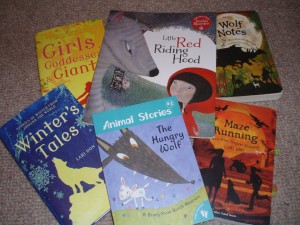| Archive for September, 2013
Filled under: Maze Running, Myths, legends, folklore, Novels, Picture Books, Research, Uncategorized, Writing | Wednesday, September 4th, 2013 |
I’ve now written six books with wolves inside, five of which have a wolf on the cover, and two of which even have a wolf in the title.
Just last week, the wolfiest book of all was published. The Hungry Wolf is a retelling of all the best ‘daft wolf tries to eat clever lamb’ stories I could find, stunningly illustrated by Melanie Williamson.
But there are lots of wolves in my other books too:
There’s a helpful wolf in the last story in Girls, Goddesses and Giants, my recent collection of heroine stories.
There’s a smooth-talking sharp-toothed wolf in Little Red Riding Hood.
Sylvie, the rather snappy wolf girl, appears in both Wolf Notes, the second novel in the First Aid series, and Maze Running, the last of the series.
And I have a collection of Winter’s Tales coming out later this year (just in time for the first frost and snow!), which has a lovely lemon-yellow wolf on the cover and a howling wolf story inside.
There is no one other creature, apart from possibly 11 year old girls, that I have written about as often as I have written about wolves.
So what is it about wolves that draws me and so many other writers to them? (Many of my favourite kids’ books are about wolves, like Michelle Paver’s Wolf Brother, or werewolves, like Roy Gill’s Daemon Parallel… To save me listing lots more, here are seven of my favourite wolf books for adults from the Scottish Book Trust website…)
So, what is it about wolves?
There are many theories about people’s fascination with wolves, but I think I know why I’m drawn as a writer to stories about wolves, why I love retelling ancient wolf stories and creating new wolf stories.
Wolves are both cool and scary. They are beautiful creatures, but they are also dangerous. And what’s so handy for writers is that EVERYONE has a reaction to wolves. Wolves are story shorthand for lots of useful, dramatic things. We don’t need to explain wolves. So wolves are a bit like dragons, which are also fascinating, beautiful and very dangerous. Perhaps wolves are the real world equivalent of dragons…
In stories, wolves can be equally convincing and equally useful to the plot as either a friend or an enemy (or, like Sylvie in Wolf Notes, as a mix of both.) So wolves can be tricksters: never entirely trustworthy, just as likely to be a baddie as a goodie, and very likely to move the story in unpredictable ways. That’s why one of my favourite mythical wolves is Fenrir, the son of Viking trickster god Loki.
One of the reasons I tell so many wolf stories is that so many cultures tell wolf stories. Almost every part of the world has had wolves as a main predator at some time, so wolves appear in lots of stories. This is another similarity between wolves and dragons, which are also an almost universal story baddie. (I know Irish dragon stories and Chinese dragon stories, Greek dragon stories and Scandinavian dragon stories; but I also know native American wolf stories and Viking wolf stories, Scottish wolf stories and Sanskrit wolf stories.) It is fascinating to see how the role and character of the wolf changes across cultures: almost always a baddie in Europe, often a wise goodie in native American culture.
I have a personal reason for feeling strongly about wolf stories too. I used to be scared of dogs, ‘cross the road if a dog was walking towards me on a lead’ type scared. Then I spent months researching wolves’ social organisation and intelligence for Wolf Notes. Once I understood a bit about wolves, I suddenly realised that I understood a bit about dogs too – mainly that they weren’t remotely interested in me because I was neither another dog nor their owner / pack leader – so I stopped being scared of them. Which just shows that writing books about wolves can change your life.
So, now I have six wolf books on my shelves. I wonder what wolf I will write next…
What animal are you particularly drawn to writing (or reading) about, and do you know why?
 a pack of wolves |
Recent Comments